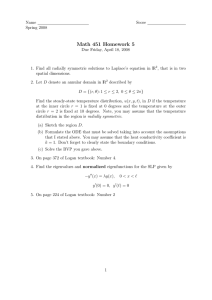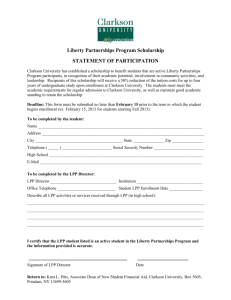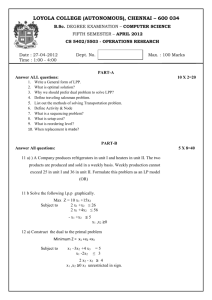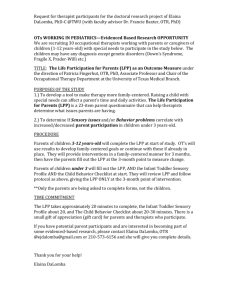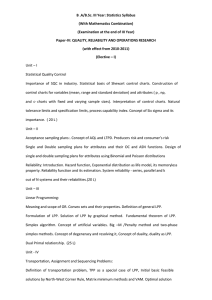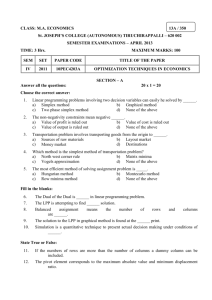This file was created by scanning the printed publication.
advertisement
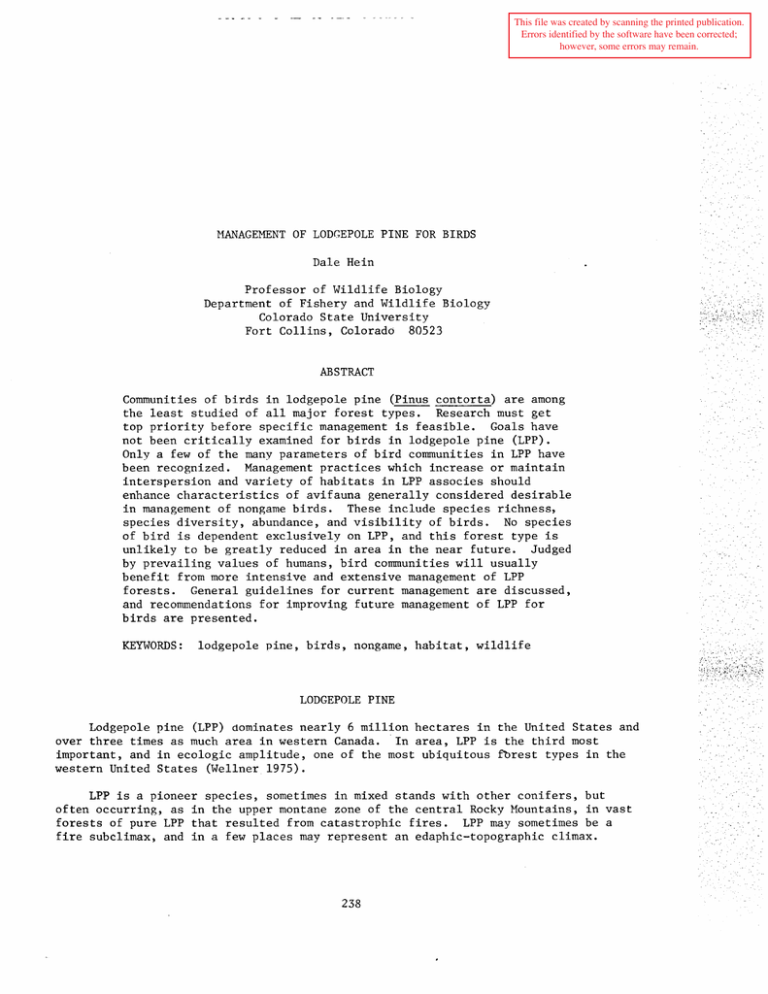
This file was created by scanning the printed publication. Errors identified by the software have been corrected; however, some errors may remain. HANAGEMENT OF LODGEPOLE PINE FOR BIRDS Dale Rein Professor of Wildlife Biology Department of Fishery and Wildlife Biology Colorado State University Fort Collins, Colorado 80523 ABSTRACT Communities of birds in lodgepole pine (Pinus contorta) are among the least studied of all major forest types. Research must get top priority before specific management is feasible. Goals have not been critically examined for birds in lodgepole pine (LPP). Only a few of the many parameters of bird communities in LPP have been recognized. Management practices which increase or maintain interspersion and variety of habitats in LPP associes should enhance characteristics of avifauna generally considered desirable in management of nongame birds. These include species richness, species diversity, abundance, and visibility of birds. No species of bird is dependent exclusively on LPP, and this forest type is unlikely to be greatly reduced in area in the near future. Judged by prevailing values of humans, bird communities will usually benefit from more intensive and extensive management of LPP forests. General guidelines for current management are discussed, and recommendations for improving future management of LPP for birds are presented. KEYWORDS: lodgepole pine, birds, nongame, habitat, wildlife LODGEPOLE PINE Lodgepole pine (LPP) dominates nearly 6 million hectares in the United States and over three times as much area in western Canada. In area, LPP is the third most important, and in ecologic amplitude, one of the most ubiquitous fbrest types in the western United States (Wellner 1975). LPP is a pioneer species, sometimes in mixed stands with other conifers, but often occurring, as in the upper montane zone of the central Rocky ~fountains, in vast forests of pure LPP that resulted from catastrophic fires. LPP may sometimes be a fire subclimax, and in a few places may represent an edaphic-topographic climax. 238 In the central Rocky Mountains, pole timber is the primary stocking class of LPP forests, often with little potential for saw timber because of over-mature trees, overly dense stands, and poor sites (Alexander.1974). Only 5 to 6 percent of the stands are seedlings and saplings. LPP often forms a dense, single-story canopy with virtually no understory and sparse lower strata. Ecology and characteristics of LPP were described in a number of papers included in Baumgartner (1975), especially Pfister and Daubenmire (1975). MANAGEMENT OF LODGEPOLE PINE Lodgepole pine (LPP) was virtually unmanaged and unharvested until the 1950's (Bernsten 1975). During the 1960's, clearcutting of LPP increased and so did public concern for environmental impacts of timber management. This stimulated research for management of LPP. A benchmark was reached in October 1973 with a symposiu~, Management of Lodgepole Pine Ecosystems (Baumgartner 1975). Management of LPP has focused on cutting practices, regeneration, disease and insect control, and occasionally on thinning. Recent research in fire management in LPP has scarcely been applied on a significant scale. Tackle (1954) recognized early that clearcutting was the most practical method of harvesting LPP forests. Lotan and Alexander (1973) stated that the choices were usually clearcut or uncut LPP because of problems of windthrow, spread of dwarf mistletoe, and slash management in various partial cutting alternatives. However, exceptions for partial cutting of LPP occur occasionally (Alexander 1972). Clearcuts can be patch, block, or strip, and there are no advantages to clearcuts larger than 16 hectares (Alexander 1974). Recommended stocking densities for multiple use management featuring timber production are above 1500 seedlings or saplings per hectare (Alexander 1974). Optimum stocking levels for timber production can be calculated from average tree diameter and basal area on the site (Adams 1969), e.g., from.600 to 1000 per hectare for trees 20 centimeters in diameter. Insects and disease are sometimes controlled in LPP by sanitation and salvage clearcutting tailored to specific situations. Precommercial thinning at about 20 years of age and commercial thinning of LPP can be successful cultural practices but are seldom done (Cole 1975). BIRDS IN LODGEPOLE There have been few extensive studies of avifauna in lodgepole pine (LPP) communities; data are especially scarce for non-nesting seasons. Snyder (1950) and Salt (1957) provided the most detailed studies of birds in LPP. Wiens (1975) reviewed avian communities in coniferous forests using a data base of 130 censuses of breeding birds in the literature. Wiens (1978) used 29 of those censuses in review of nongame birds in Pacific Northwest coniferous forests. From those useful reviews, I extracted data from eight studies which reported bird censuses in lodgepole forests; most were from mixed forest types and mainly from the central Rocky Mountains. Data from Roppe and Rein (1978) and unpublished data (on file with the author at Colorado State University, Fort Collins) were also used for the following discussion. Apparently, there are no other published studies of bird communities in LPP. a The most abundant species nesting in lodgepole habitat in Colorado (Rappe and Rein 1978) include Yellow-rumped (Audubon's) Warbler, Ruby-crowned Kinglet, Grayheaded Junco, Hermit Thrush, Black-capped and Mountain Chickadees, Pine Siskin, Gray Jay, and Townsend's Solitaire (standard common names currently in use by American Ornithologists' Union). "Parus-Spinus" (Chickadee-Siskin) was a proposed name for this avian community (Snyder 1950). No species of bird is restricted to LPP. Birds in lodgepole habitat often occupy diverse, broad niches. The few species which use lodgepole for food rank low in abundance among species in this habitat. Blue grouse is the only important game bird and the only species feeding significantly 239 on LPP foliage in most lodgepole communities. Clark's Nutcracker and Pine Grosbeak eat lodgepole seeds and are more closely associated with LPP than are other birds; however, they are low in abundance in the community and are more common in types dominated by spruces and true firs. The most abundant guild of birds in LPP is comprised of species which feed on insects on live foliage and bark. This guild includes kinglets, warblers, chickadees, and nuthatches. Niches of these species may be more finely divided and specialized than are niches of birds in other guilds which use different parts of LPP habitat (Sabo and Whittaker 1979). Communities of birds nesting in LPP forests exhibit highly variable and intermediate densities (150-900 per square kilometer) and standing crop biomass (25-200 grams per hectare) (Wiens 1975). Number of species is typically low (8-20) as is species diversity. Roppe and Rein (1978) calculated a value of 3.0 for ShannonWiener index of species diversity of breeding birds in LPP in Colorado. Species dominance is high, with one species often accounting for one-fourth of all birds, and the two most-abundant species including half of all birds. Diversity of vegetation in LPP communities appears to affect several parameters of the associated avifauna. Comparing four studies in LPP with five studies in LPPmixed conifer communities, species richness, density and biomass were higher in the mixed communities, but species dominance was greater in the avifauna of the pure LPP (Table 1). Table I.--Comparison of parameters of bird communities in lodgepole pine and lodgepole pine-mixed coniferous forests; data are from Wiens (1975) and Roppe and Rein (1978), mainly from Rocky Mountains. Communities and number of studies Statis tic Number of species Density (birds/km2 ) Standing crop biomass (g/ha) Dominance (2 species) Lodgepole pine (4) Range: Mean: 8-14 11 146-322 238 25-73 54 41-65% 53% Lodgepole pinemixed conifer (5) Range: Mean: 10-20 14.4 493-905 713 126-204 149 26-46% 33% Effects of habitat disturbance on birds of LPP have seldom been studied. Roppe and Rein (1978) used standard techniques of spot-mapping territories to compare bird populations on a 8-year-old burn, ecotone, and unburned lodgepole forest in northcentral Colorado. Breeding densities of birds per 100 hectares were 108 pairs in the burn, 110 pairs in the ecotone and 73 pairs in lodgepole. Standing crop biomass and consuming biomass were higher on the burn, but efficiency of food utilization by avifauna was higher in unburned lodgepole. The ecotone between the LPP and burn had more individuals and more species of birds than did either of the other habitats. There were 14 species in LPP, 13 in the burn, and 18 in the ecotone. The Shannon-Wiener index of species diversity was 3.3 for the burn and 3.0 for the LPP. Abundant species, such as Blue Grouse and Clark's Nutcracker, occurred on both sites. American Robin, Mountain Bluebird, Broad-tailed Hummingbird, Common Flicker, and Empidonax flycatchers, occurred mainly on the burn in place of Hermit Thrush, Ruby-crowned Kinglet, and chickade~s in LPP. Thus, the greatest differences between the two communities of birds were in species composition and relative abundance of some of the most common 240 species. Because most birds in LPP forests are euryoecious, noticeable changes in relative abundance can be expected to occur at lower levels of habitat change than is required to affect species composition. Apparently, no substantial studies have been publishe·d on bird populations in LPP in nonbreeding seasons. Unpublished data on file with the author at Colorado State University, were collected by Alan Dale to compare birds on a clearcut and adjacent mature LPP forest in Larimer County, Colorado, in late winter. The data are from area transect counts replicated five times on two 10-hectare plots, one in each community. Although the data are meager (Table 2), species richness, species diversity and abundance were higher in LPP than in the clearcut in winter. Mountain Chickadee was the only one of eight species recorded in both habitats. Table 2.--Comparison of late-winter birds during five area transect counts on two 10hectare plots, one in a clearcut and one in adjacent mature lodgepole pine forest, Larimer County, Colorado, March-April 1977. Clearcut Maximum number Frequency Goshawk Hairy Woodpecker Gray Jay Mountain Chickadee American Robin Bohemian Waxwing Pine Grosbeak Gray-headed Junco 2 60% 8 20% 4 60% Lodgepole Maximum number Frequency 1 2 2 7 1 60% 40% 60% 80% 40% 4 20% MANAGEMENT OF LODGEPOLE FOR BIRDS Perspectives and Discussion The paucity of information concerning effects on wildlife of manipulation of lodgepole pine (LPP) is surprising. A few studies on responses of big game to management of LPP were reviewed by Dealy (1975), and there were a few reports of small mammal populations and LPP management, usually from the viewpoint of damage to LPP by mammals, e.g., Lindsey (1975). The only mention of birds in the 37 papers in the 1973 symposium on LPP management (Baumgartner 1975) was to allude to their "damaging" (which could be called "utilizing") of LPP (Lindsey 1975). Foresters have attempted to develop management prescriptions for LPP in which effects on wildlife are considered. For example, one national forest in Colorado, in developing its timber management plan in 1977, predicted the impact on wildlife of up to four alternative treatments on six stand combinations of LPP. From a base index value of 100 for no effects of no treatment, the index was projected only as high as 114 for thinnings followed by patch clearcuts and only as low as 94 for light shelterwood cuts in sawtimber on poor sites. These were subjective predictions for numbers and distributions of five combined categories -of wildlife -big game, small game, nongame, fishes, and reptiles. Clearly, little can be inferred about forest management for nongame birds when such a broad, subjective approach is used, even by competent 241 forest-wildlife biologists. Negligible effects are almost certain on a combined wildlife index from almost any timber management; adverse and beneficial effects on different species often cancel each other out in the index, giving a misleading indication of no effect. Forest managers are not to blame for using a crude method when nothing better is available. We are not ready to manage LPP for nongame birds. The data base is inadequate and goals are not established. Fortunately, we don't face critical situations for nongame birds in LPP. There are no birds restricted to LPP, no endangered species that depend primarily on LPP for habitat, and little likelihood that much of the vast area of LPP forest will be significantly altered in the 1980's. We have an unusual opportunity to "do it right" in LPP. First, we should describe the avifauna of LPP communities--not just annot~ted lists, but quantification of parameters of bird communities including species composition, relative and absolute abundance, standing crop and consuming biomass, energy flow, trophic structure, species diversity, dominance, association, interdependence, periodicity, and productivity. Many parameters can be estimated from simple listcount data, if surveys are designed properly. More complex studies and models are needed to estimate characteristics such as productivity, resiliency, and energy flow. Detailed ecologic investigations of species are also needed to describe niches, define guilds, and identify key species for featured species management. Second, we should·document effects of LPP manipulation and succession on bird communities. Most effective and practical would be a series of well-designed surveys at all seasons before and after manipulation of LPP. Often, these studies could be adapted to concurrent timber management activities. Similar site comparisons (Roppe and Hein 1978) can also be used for faster but less precise assessment of effects of habitat change. Studies of bird population changes after forest changes in other community types (Bock and Lynch 1970, Franzreb 1977, Hagar 1960, and Kilgore 1971) provide only useful starting points for designing the needed research. Third, we need goals for management of nongame birds in LPP. A lack of defined goals and objectives is a general problem for wildlife management in western forests (Miller 1978). Do we have even tentative goals? Traditional emphasis of game managers on numbers has undoubtedly pervaded our thinking about nongame birds. Recently, there have been some healthy reservations about maximizing diversity. Odum (1969) described three components of diversity--variety, stratification and evenness-and how these differ from species richness. From the preservationists, we have probably accepted an overemphasis on making stability of bird communities a goal. We need a broad perspective to think in terms of spatial and temporal mixes of successional stages of LPP. For birds in LPP, regular and mild perturbation of habitat for "pulse stability" appears to be a less desirable alternative to creating a mosaic of successional stages over large areas by means of severe perturbations (Odum 1969). Maximizing numbers, distributions, diversity, species richness, or stability of birds may not be appropriate goals in management of many LPP situations. Perhaps visibility of birds and access by humans to birds in LPP may be more important goals in some cases. Decisions on forest roads, campgrounds and trails may be more important than cutting or burning to enhance opportunities for persons to enjoy birds and thereby achieve personal objectives for use of birds in LPP. Relatively low value of LPP for timber, big game and livestock grazing in many cases, could help justify a top management priority for birds in LPP more frequently than in any other major forest type in western North America. Thus, the opportunity to manage LPP for birds may depend more on developing economical and effective techniques than on resolving conflicts with otherresource values. In this respect, fire may be preferred to cutting to achieve management goals for birds in LPP. 242 .. :. A practical approach to management of forest habitat for wildlife was described by Thomas et al. (1976), who argued that management decisions are being made now and that wildlife biologists must do their best now to predict effects of habitat changes on wildlife. Briefly, all species of vertebrates in an area were grouped into "life forms" based on required reproduction sites and feeding habitat. ~vildlife information was organized on four levels from gross responses of life forms to habitat changes to available biological information and literature references for individual species. Effects on wildlife, primarily changes in abundance of life forms, could then be predicted for changes in timber types, successional stages and temporal and spatial arrangements of stands. This approach is being applied now in better-studied forest communities and may be useful for nongame birds in LPP in the future. However, I contend that ecology of nongame birds is too poorly known to apply this approach with confidence in LPP at this time. Also, abundance of species or groups may be overemphasized as a community parameter. I also favor more emphasis on traditional basis of grouping species into guilds according to ecologic function, instead of into life forms based on a few habitat uses. The approach of Thomas et al. (1976) is due for a detailed presentation in a book to be published soon. Some Guidelines Management options for lodgepole pine (LPP) usually reduce density of the canopy to varied degrees by various cutting practices or by burning. Thinning which retains uniformity of spacing has less influence on birds in LPP than does thinning based on a diameter limit, which results in a mosaic of habitat types similar to results of some fires that enhance many desirable features of bird communities. Optimum thinning densities are probably slightly lower for birds than for timber production. Research in progress and general observations indicate that thinning by diameter limit to fewer than 750 trees per hectare may be recommended where birds have top priority. This will permit ground cover to develop and facilitate stratification in the stand. Thinning old stands that won't respond to release cutting is still beneficial for wildlife. Blowdown in thinned stands can also benefit birds such as wrens that forage in dense, low cover. Fire suppression in this century, and to a lesser degree control of insects and dwarf mistletoe, has resulted in an unnatural preponderance of dense, stagnant stands of LPP--the "doghair," monotonous forests that challenge managers. Unnaturally high accumulations of fuel have made difficult a return to natural fire policy, and research on prescribed burning in LPP has not yet led to extensive application of fire. If "naturalness" is a goal for bird communities in LPP, then a general guideline is that fire will help restore natural bird communities in our LPP forests. Fire should be a welcome, natural phenomenon in most LPP communities, and not just small, cool fires, but the full gamut of fires with which birds of LPP ecosystems evolved. Conclusions of Dealy (1973) on management of LPP ecosystems for range and wildlife supported several important guidelines for cutting LPP that would be compatible with current traditional values of abundance and species richness of birds as well as beneficial for management of ungulates. Block or patch clearcuts should not exceed 16 hectares. Alternate-strip clearcuts should not exceed 60 meters in width with equal leave strips. Leave patches and irregular margins are desirable to increase edge and habitat diversity (Thomas et al. 1978). Value and practicality of leaving snags during cutting of LPP is uncertain. Few suitable snags may exist in many even-aged stands, and isolated lodgepole pines are seldom windfirm. Bull (1978) showed that 40 to 180 snags per 40 hectares were needed for maximum population density of four species of woodpeckers characteristically inhabiting LPP forests in the Pacific Northwest. It was assumed that requirements of secondary cavity nesters would simultaneously be met if needs of excavators 243 (woodpeckers) for snags were satisfied. Leaving an average of five snags per hectare is a tentative guideline that needs to be evaluated with appropriate research. Special consideration should be given to raptors in LPP forests. Carnivores integrate information about lower trophic levels. Top carnivores represent disproportionately high investments of energy and information from the community, and they may have important regulatory roles. Requirements of raptors in LPP are little known. Shuster (1976) found one Goshawk nest per 1640 hectares in 81 square kilometers of mainly LPP habitat in Colorado. All nests were within 2 kilometers of main roads, but whether or not special protection was needed was unclear. Disruptive activity, such as cutting or burning, should be banned in any unusual case where a LPP stand is inhabited by a rare, endangered, or unique bird, such as an Osprey, Peregrine Falcon, or Goshawk. RECOMMENDATIONS (1) More research should be initiated on avifauna of lodgepole pine (LPP) and on the responses of bird communities to various habitat changes in LPP. Specific hypotheses should be tested with before-and-after surveys at all seasons on replicated pairs of treated and control plots. \ (2) Goals must be established for management of birds in LPP. Meaningful public involvement should occur in determining these goals for individual units, such as each national forest or ranger district. Many characteristics of bird communities should be considered, not just abundance and number of species. (3) Management prescriptions should be implemented with stated objectives on at least 1 to 2 percent of LPP on each national forest each year. (4) ~1anagement of LPP should be evaluated in relation to objectives for birds, and results should be published. LITERATURE CITED Adams, David L. 1969. Stocking levels for lodgepole pine. Ph.D. Dissertation. Colorado State Univ., Fort Collins, 164 p. Alexander, Robert R. 1972. Partial cutting practices in old-growth lodgepole pine. USDA For. Serv. Res. Pap. RM-92, 16 p. Rocky Mt. For. and Range Exp. Stn., Fort Collins, Colo. Alexander, Robert R. 1974. Silviculture of central and southern Rocky Mountain Forests. USDA For. Serv. Res. Pap. RM-120, 36 p. Rocky Mt. For. and Range Exp. Stn., Fort Collins, Colo. Baumgartner, David M. (ed.) 1975. Management of lodgepole pine ecosystems. Symposium Proc. 825 p. Washington State Univ. Coop. Ext. Serv., Pullman. Bernsten, Carl M. 1975. Management conflicts in lodgepole pine. In Management of lodgepole pine ecosystems. Symposium Proc. D. M. Baumgartner, ed. p. 503-515. Washington State Univ. Coop. Ext. Serv., Pullman. Bock, Carl E., and James F. Lynch. 1970. Breeding bird populations of burned and unburned conifer forest in the Sierra Nevada. Condor 72:182-189. 244 Bull, Evelyn L. 1978. Specialized habitat requirements of birds: snag management, old growth, and riparian habitat. In Proc. workshop on nongame bird habitat management in the coniferous forests of the western United States. R. M. DeGraaf, tech. coord. p. 74-82. USDA For. Serv. Gen. Tech. Rep. PNW-64. Pac. Northwest For. and Range Exp. Stn., Portland, Oreg. Cole, Dennis M. 1975. Culture of immature lodgepole pine stands for timber objectives. In Management of lodgepole pine ecosystems. Symposium Proc. D. M. Baumgartner, ed. p. 536-555. Washington State Univ. Coop. Ext. Serv., Pullman. Dealy, J. Edward. 1975. Management of lodgepole pine ecosystems for range and wildlife. In Management of lodgepole pine ecosystems. Symposium Proc. D. M. Baumgartner-,-ed. p. 556-580. Washington State Univ. Coop. Ext. Serv •• Pullman. Franzreb, Kathleen E. 1977. Bird populations changes after timber harvesting of a mixed conifer forest in Arizona. USDA For. Serv. Res. Pap. RM-184, 26 p. Rocky Mt. For. and Range Exp. Stn., Fort Collins, Colo. Hagar, Donald C. 1960. The interrelationships of logging, birds, and aimber regeneration in the Douglas-fir region of northwestern California. Ecoiogy 41:116-125. Kilgore, Bruce M. 1971. Response of breeding bird populations to habitat changes in a giant sequoia forest. Am. Midl. Nat. 85:135-152. Lindsey, Gerald D. 1975. The influence of animals on lodgepole pine regeneration. In Management of lodgepole pine ecosystems. Symposium Proc. D. M. Baumgartner,-ed. p. 457-470. Washington State Univ. Coop. Ext. Serv., Pullman. Lotan, James E., and Robert R. Alexander. 1973. Lodgepole pine. In Silvicultural systems for the major forest types of the United States. p. 42-45. USDA For. Serv. Handb. 445. Washington, D.C. Miller, Rod 1978. Guidelines for wildlife management in western coniferous forests. In Proc. workshop on nongame bird habitat management in the coniferous forests of the western United States. R. M. DeGraaf, tech. coord. p. 70-73. USDA For. Serv. Gen. Tech. Rep. PNW-64. Pac. Northwest For. and Range Exp. Stn., Portland, Oreg. Odum, Eugene P. 1969. The strategy of ecosystem development. Science 164:262-270. Pfister, Robert D., and R. Daubenmire. 1975. Ecology of lodgepole pine. In Management of lodgepole pine ecosystems. Symposium Proc. D. M. Baumgartner, ed. p. 27-46. Washington State Univ. Coop. Ext. Serv., Pullman. Roppe, Jerry A., and Dale Rein. 1978. Effects of fire on wildlife in a lodgepole pine forest. Southwestern Nat. 23:279-288. Saba, Stephen R., and Robert H. Whittaker. 1979. Bird niches in a subalpine forest: an indirect ordination. Proc. Natl. Acad. Sci. 76:1338-1342. Salt, G. Wm. 1957. An analysis of avifauna in the Teton Mountains and Jackson Hole, Wyoming. Condor 59:373-393. Shuster, William C. 1976. Northern goshawk nesting densities in montane Colorado. Western Birds 7:108-110. Snyder, Dana P. 1950. Bird communities in the coniferous forest biome. Condor 52:17-27. 245 Tackle, David. 1954. Lodgepole pine management in the Intermountain Region--a problem analysis. USDA For. Serv. Misc. Pub. RM-2, 53 p. Rocky Mt. For. and Range Exp. Stn., Fort Collins, Colo. Thomas, Jack Ward, Chris Maser, and Jon E. Rodiek. 1978. Edges--their interspersion, resulting diversity and its measurement. It• Proc. workshop on nongame bird habitat management in the coniferous forests of the western United States. R. M. DeGraaf, tech. coord. p. 91-100. USDA For. Serv. Gen. Tech. Rep. PNW-64. Pac. Northwest For. and Range Exp. Stn., Portland, Oreg. Thomas, Jack Ward, Rodney J. Miller, Hugh Black, Jon E. Rodiek, and Chris Maser. 1976. Guidelines for maintaining and enhancing wildlife habitat in forest management in the Blue Mountains of Oregon and Washington. Trans. N. Am·. Wildlife and Natural Resource Conf. 41:452-476. Wellner, Charles A. 1975. The importance of lodgepole pine in the United States. In Management of lodgepole pine ecosystems. Symposium Proc. D. M. Baumgartner, ed. p. 1-9. Washington State Univ. Coop. Ext. Serv., Pullman. '.Jiens, John A. 1975. Avian communities, energetics, and functions in coniferous forest habitats. In Proc. symposium on management of forest and range habitats for nongame birds. Dixie R. Smith, tech. coord. p. 226-265. USDA For. Serv. Gen. Tech. Rep. W0-1. Washington, D.C. Wiens, John A. 1978. Nongame bird communities in northwestern coniferous forests. In Proc. workshop on nongame bird habitat management in the coniferous forests of the western United States. R. M. DeGraaf, tech. coord. p. 19-31. USDA For. Serv. Gen. Tech. Rep. PNW-64. Pac. Northwest For. and Range Exp. Stn., Portland, Oreg. 246
